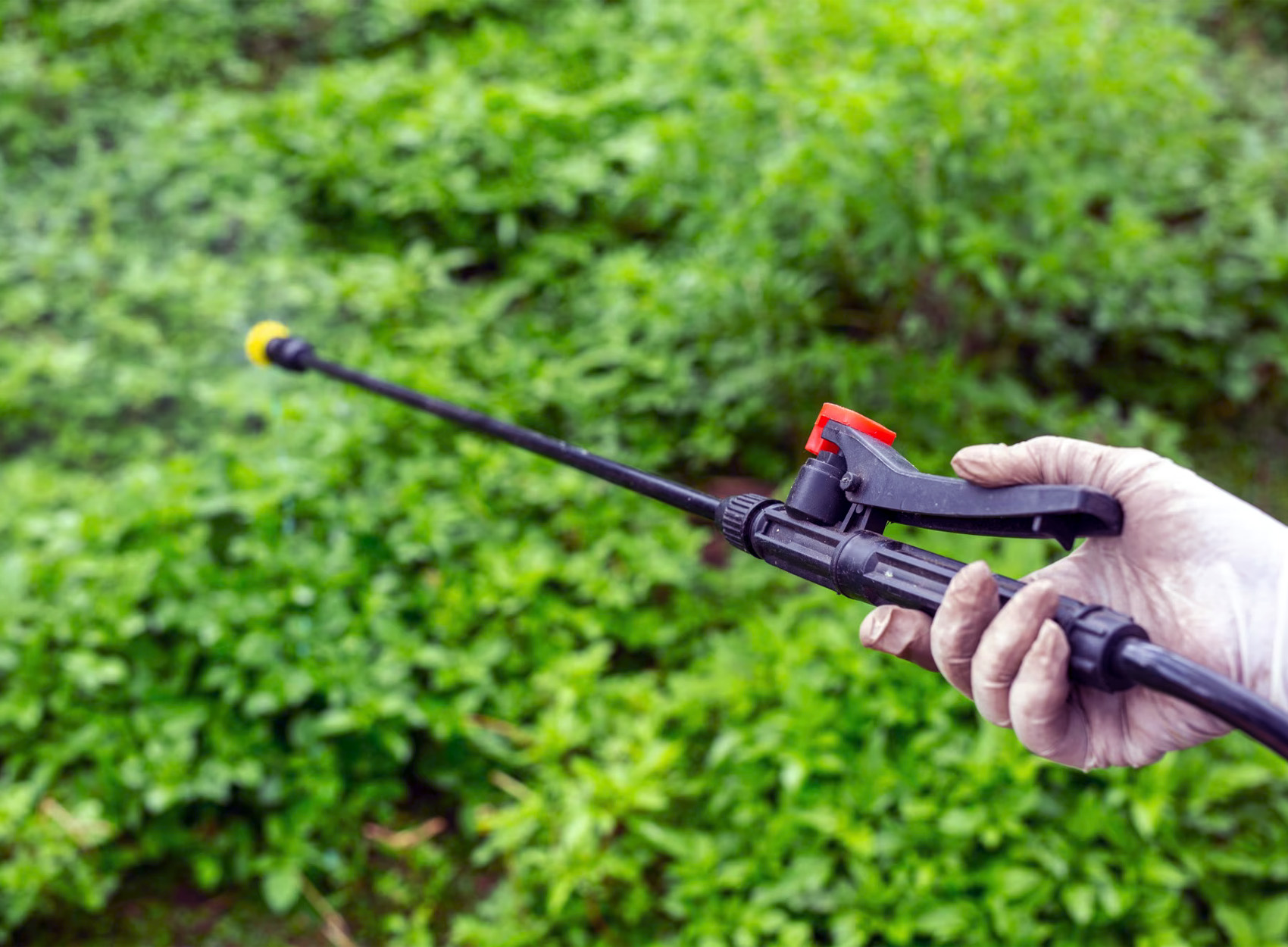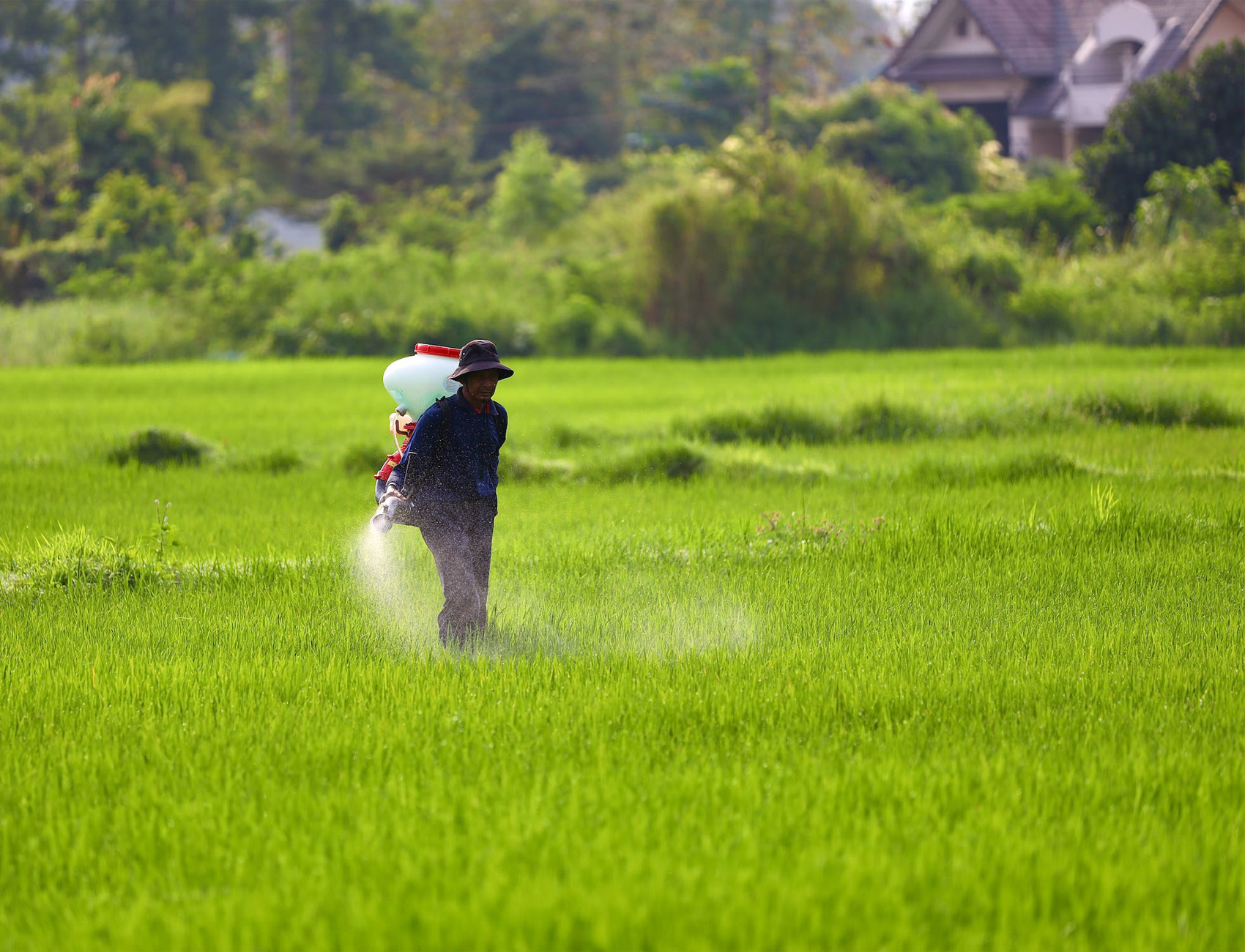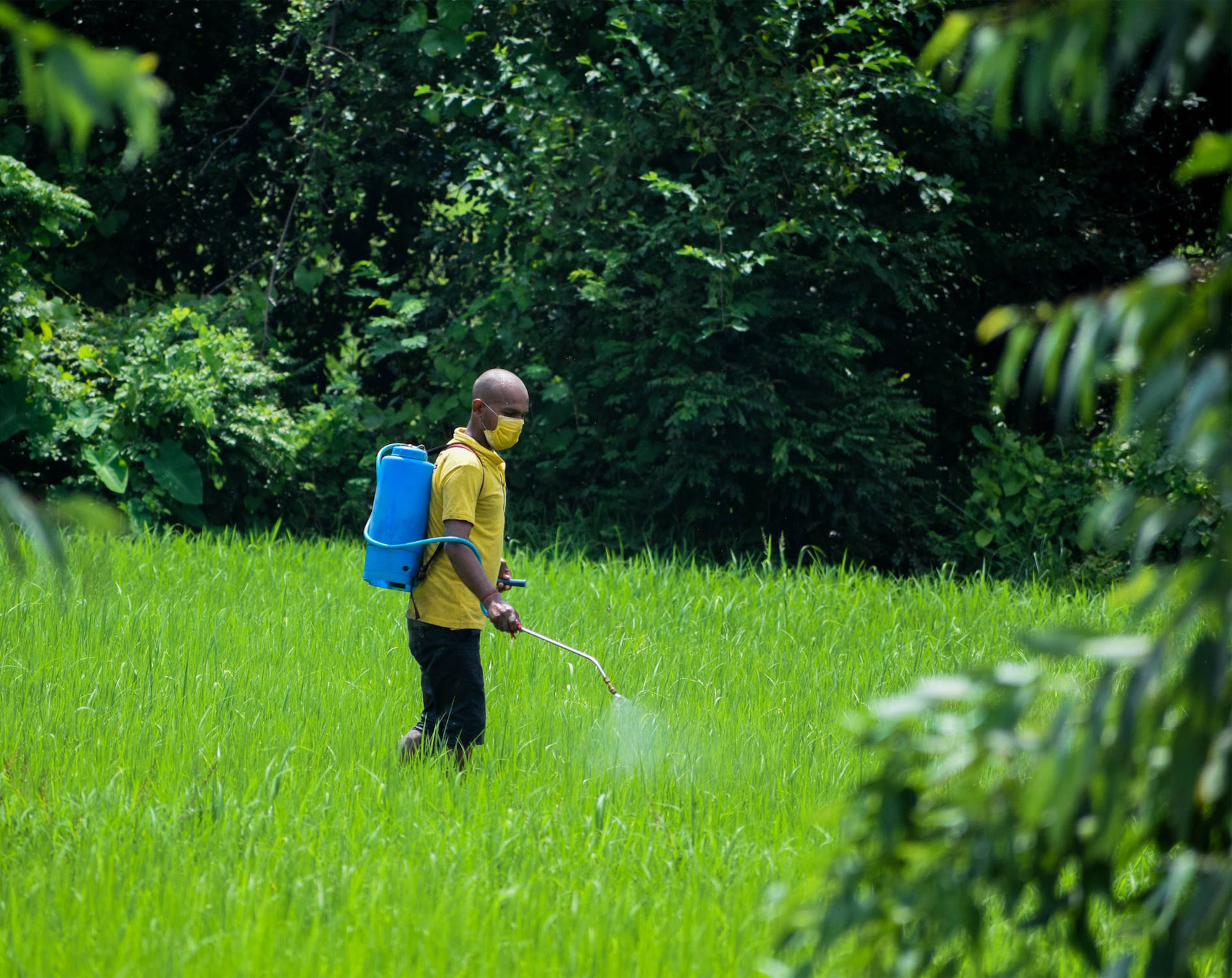How Much 2,4-D Per Gallon Of Water
The most common ratio I use when mixing 2,4-D concentrate with water is 2.5 ounces (5 tablespoons) of 2 4-D per gallon of water to cover a roughly 400 sq ft area of grass. 2 4-D is short for the active ingredient 2,4-dichlorophenoxyacetic acid. It’s a special herbicide formula that’s very effective at controlling broadleaf weeds and is found in over 100 different herbicide products sold in the United States. It’s been used as a pesticide since the 1940s and is produced by a variety of manufacturers for vegetation control.
2,4-D is especially effective at controlling weeds without affecting turf grasses making it one of the most popular weed killers for lawns.
In addition to mixing 2,4-D with water, you must also use a surfactant. Surfactants are compounds that cause herbicides to stick to plants, which increases their effectiveness. Make sure you combine 2,4-D with a commercial surfactant or some dish soap before spraying it on your lawn.
Although 2,4-D is sold in ready-to-use form, it’s also available in a liquid concentrate that’s mixed with water before use. But not all 2,4-D concentrate is sold in the same potency. Some concentrates are stronger than others so you must vary your mix ratio accordingly.
Managing lawn weeds with 2,4-D requires a proper mix ratio when it comes in concentrate form. Variation of the mix ratio may result in poor weed control and/or dead grass so be careful when mixing 2,4-D with water.
2,4-D is generally considered safe for grass and honeybees when used properly. It can kill a wide variety of common weeds found in our lawns. But it can also kill many garden plants, trees, and shrubs. Be careful when using it and make sure to follow the correct mix ratio of 2,4-D to water per gallon.
2, 4-D Mix Ratio Per Gallon Of Water
I use 5 tablespoons (2.5 oz) of 2,4-D per gallon of water per roughly 400 square feet of grass. However, how much 2,4-D amine per gallon of water you use depends on the application method you choose and the strength of the concentration.
- Liquid concentrate 2,4-D that’s mixed with water before use is sold in different strengths. Standard strength 2,4-D has a mic ratio of 5 tablespoons (2.5 oz) of 2,4-D / 1 gallon of water. But you must vary the ratio if you use a stronger concentrate.
- How you apply 2,4-D to your grass effects the mix ratio.
- 2,4-D comes in several chemical forms, such as acids, salts, and ester.
2,4-D is an herbicide that kills broadleaf weeds. It changes causes the cells carrying water and nutrients to the weeds to divide and grow non-stop. This change in the weed’s growth pattern results in a dead weed.
Using the right 2,4-D / water mixing ratio is very important if you want to effectively control weeds. Using too little may not kill the weeds so you’ll need repeated applications. Use too much and you could kill plants, trees, flowers and shrubs in addition to the weeds.
How much 2,4-D you mix per gallon water may vary depending on how you’ll be applying it.
How To Mix 2,4-D For A Hand Pump Sprayer Or Backpack
When using a handheld tank or backpack sprayer, I use the standard 2,4-D mixing ratio of 5 tablespoons (2.5 oz) liquid concentrate / gallon of water to treat approximately 400 square feet of grass. If you’re treating 800 square feet of grass, double the ratio to 10 tablespoons (5 oz) liquid concentrate 2,4-D / 2 gallons of water. Keep this ratio as you scale the total amount of herbicide you need for the property size you’re treating.
- You can double that by mixing 5 ounces of concentrate in 2 gallons of water to treat 800 square feet.
- 7.5 ounces in 3 gallons of water will treat 1,200 square feet of lawn.
- Apply the herbicide in an even sweep over the to should provide adequate coverage.
- Don’t drench the grass to the point where it pools.
- Pour 2,4-D into the sprayer first. Then add the correct amount of water to dilute the 2,4-D.
Apply 2,4-D herbicide evenly over the entire lawn. Spray lightly so that the grass is damp but there aren’t pools collecting on the soil.
How To Mix 2,4-D For Hose-End Sprayers
You can attach a multi-use hose end sprayer and reservoir to the end of a garden hose to mix 2,4-D in the correct ratio as you spray water. Set the dial to release 2.5 oz of liquid concentrate 2,4-D per gallon of water. Do not add water to the reservoir. The sprayer will automatically dilute the liquid 2,4-D concentrate as water from the garden hose flows through it.
Most multi-use spray applicators that attach to the end of your garden hose will hold 6.5 ounces of herbicide, for 1,000 square feet of lawn, or up to 16 ounces of herbicide in the reservoir.
- Don’t add water to the reservoir. The sprayer will automatically dilute liquid 2,4-D concentration in the correct amount as water flows through the garden hose.
- Make sure the end sprayer is set correctly. Use too much 2,4-D and you could kill grass, flowers, trees and shrubs. But use too little and you’ll have a hard time killing weeds.
A 32 oz reservoir used with the proper settings will treat approximately 5,000 square feet of yard which is over a 10th of an acre.
How To Mix 2,4-D For Spray Bottles
Spray bottles are a great way to make spot treatments on small areas of weeds in your garden or lawn. Make sure to use a pesticide spray bottle when using 2,4-D. Dilute 2.5 tablespoons (1.25 oz) of 2,4-D in a 32oz spray bottle with water to treat a 250-square-foot yard. Start by adding herbicide the bottle, followed by fresh water to the full line. Then gently swish the bottle around to mix the water and 2,4-D together.
For small spot treatments, mix 1.5 tablespoons of concentrate in half a gallon of water and fill the bottle as needed.
Finish by adding some approved surfactant or dish soap to your mixture.Then swish the bottle again to mix the surfactant with your herbicide mixture.
Surfactants are compounds that cause herbicides to stick to plants, which increases their effectiveness. Make sure you combine 2,4-D with a commercial surfactant or some dish soap before spraying it on your lawn.
- Add 2,4-D to your 32 oz pesticide spray bottle first.
- Then fill the bottle with fresh water to the full line and swish the bottle around to mix the compounds.
- Finally, add a surfactant or dish soap to the bottle and swish the bottle again.
- 2,4-D herbicide in a spray bottle is great for spot treating weeds.
- Make sure to use a pesticide spray bottle for 2,4-D.
2,4-D Dilution Rates & Tips
2,4-D herbicides comes in two basic forms, the first is a ready-mix herbicides that’s mixed by the manufacturer. It comes already diluted and ready for spraying. The second type is a liquid concentrate 2,4-D which must be mixed with water in the correct ratio. Mixing 2,4-D with water dilutes it so that it’s not too strong for your grass.
Whenever you’re mixing your own batch of 2,4-D, follow these basic rules:
- Always dilute 2,4-D according to the manufacturer’s specifications.
- The standard mix ratio I use is 2.5 ounces (5 tablespoons) of 2 4-D per gallon of water to cover a roughly 400 sq ft area of grass.
- 2,4-D may have different dilution rates based on the manufacturer. Make sure to read the label carefully for mixing instructions and herbicide to water ratios.
- Apply diluted 2,4-D according to manufacturer’s specifications.
- 2,4-D coverage is based on square footage of lawn per diluted gallon.
Properly mixing and spraying 2,4-D will help you control weeds without damaging your lawn.
Does Mixing 2-4-D Require A Surfactant?
A Surfactant is a compound that causes herbicides to stick to plants. This increases their coverage, penetration and effectiveness. They do it by reducing the surface tension of water which creates more uniform coverage of the herbicide. When more of the herbicide covers the weed, it does a better job of killing it.
- Surfactants can be used with almost all types of herbicides, which includes 2,4-D.
- The addition of a surfactant helps 2,4-D control of broadleaf weeds.
- For 2,4-D herbicide, it’s recommended to use a non-ionic surfactant.
- Do not add a surfactant to ready-mix 2,4-D spray.
- Surfactants increase the effectiveness of 2,4-D liquid concentrate mixed with water.
Mix 1 teaspoon of surfactant per gallon of spray or 1 to 2 pints per 100 gallons of spray.
Dish soap can be used as a surfactant with many 2,4-D products.
Not all 2,4-D sprays require a surfactant. Some are sold as a ready-mix spray and some are a liquid concentrate that must be mixed with water before use. You should not add a surfactant to ready-mix 2,4-D spray because it’s already been formulated by the manufacturer. But you can add a surfactant to 2,4-D liquid concentrate mixed with water to increase its effectiveness.
The Best Time To Spray 2,4-D Herbicide
Generally, 2,4-D herbicide can be sprayed once in Spring and once in the Fall. However, this can vary based on the specific brand you use and where you live, so check with the manufacturer before spraying. The maximum amount of 2,4-D you can use is 1.8 gallons per acre, per season, applied in no more than two applications annually.
- The best time to apply 2,4-D herbicide is when the weeds are small and actively growing. This is usually in early spring but it can vary based on where you live.
- Adjust your first spray depending on when the local growing season begins.
- Spraying should be done on windless days so coverage will be even.
- Spray when the temperature is below 90 degrees Fahrenheit.
- The best time to spray is two days after the last mowing.
Before spraying new lawns, wait about six weeks after seeding, or four weeks after sodding, sprigging or plugging. Wait two days after spraying 2,4-D to mow the grass.
How Much 2,4-D To Treat An Acre Of Land?
It takes one gallon of 2,4-D herbicide diluted in 15 gallons of water to treat an acre of land. The maximum amount of 2,4-D you can use is 1.8 gallons per acre, per season, applied in no more than two applications annually.
- The spray volume is 5 to 20 gallons of water per acre per application by ground equipment.
- Lower dosages of 2,4-D is recommended for young and sensitive weed species.
- Higher rates are needed for less sensitive and fast-growing weed species where control is difficult.
- Since the total 2,4-D you can use per acre per season is 1.8 gallons applied in no more than 2 applications annually, you should vary how much you use and where.
- Spray lightly where you see young and sensitive weed species and heavier where you find fast-growing aggressive weeds.
- When diluting 2,4-D with water, don’t mix with oil, surfactants, atrazine, or other adjuvants unless it’s specified on the label.
- Some perennial weeds with deep roots need repeated applications for effective control.
Don’t use the same applicator or equipment for applying other products and 2,4-D or you’ll risk contaminating crops.
Is 2,4-D Harmful If Mixed Incorrectly?
Yes, mixing 2,4-D can be harmful to plants, trees, flowers, shrubs and even your lawn. Using too much 2,4-D liquid concentrate in your water can not only your weeds, but also your lawn and other nearby plants.
- 2,4-D is an excellent herbicide when used correctly.
- 2,4-D is a powerful post-emergent herbicide that can kill grass and surrounding vegetation when mixed incorrectly.
- Mixing 2,4-D incorrectly can cause injury to your crops, grass and plants.
If mixed correctly and used with proper care, 2,4-D is an effective herbicide for weed management.
Although 2,4-D is designed to attack broadleaf weeds while leaving grass unharmed, if it’s applied too heavily it can harm your grass and surrounding plant life. Signs of overuse include:
- Brown or dead grass
- Pale yellow “bleached” or “scorched” looking grass
- Dry grass that seems to lack water
- Dead or sick looking shrubs or other vegetation
Avoid damaging your lawn by mixing the liquid concentrate 2,4-D with the appropriate amount of water.
Applying too strong a mix or too much herbicide in an area will kill more weeds, but it will also kill the grass and other plants.
Mixing too little 2,4-D can also be bad for your grass and other plants because it may not kill the weeds. This means repeated applications will be needed and the weeds will have more time to spread. The longer you let the weeds live, the more the spread and the harder it is to kill them. Especially if they’re aggressive perennial weeds with deep roots.
Make sure to properly mix your 2,4-D with the correct amount of water is a very important part of weed control.
Can 2,4-D Kill Grass If Overused?
Yes, if 2,4-D herbicide is overused or mixed too strong, it can kill your lawn and other nearby vegetation. The maximum amount of 2,4-D you can use is 1.8 gallons per acre, per season, applied in no more than two applications annually. You can then scale those figures down based on the amount of land you’ll be treating.
Overusing or mixing 2,4-D too strong will kill your weeds, but it could also kill your grass, shrubs, flowers and other local plants.
- If you buy a ready-mix 2,4-D herbicide, it’s formulated at the manufacturer and doesn’t require mixing with water. As long as you spray it evenly over the correct amount of land, you won’t damage the grass.
- If you use 2,4-D liquid concentrate, you must mix it with water prior to spraying it on the lawn. It’s very important to follow the correct mix ratio. If you mix 2,4-D too strong, you risk killing the grass and other plants along with your weeds.
2,4-D is safe for most types of grass as long as it’s used and mixed properly. However, if you apply too much or mix it too strong, it may kill the grass and other nearby vegetation.
If you see dead or burnt grass in areas where you’ve sprayed 2,4-D, you probably used too much or made it too strong.
Can You Use Too Much 2,4-D?
Yes, the most 2,4-D you can use per acre of land is 1.8 gallons per acre per season, applied in no more than two applications annually. Use any more than this and you risk damaging grass, cops, trees, shrubs, flowers, etc. You can scale this ratio down to to fit any amount of land you’re treating with 2,4-D herbicide.
Stick to the standard ratio of 2.5oz of 2,4-D per gallon of water to treat 400 sq ft of lawn and you won’t risk damaging your lawn and nearby plants.
- Using too much 2,4-D can lead to scorching or burning of the lawn and surrounding vegetation.
- Excessive use of diluted 2,4-D can lead to surface runoff into nearby waterways which may harm local wildlife.
- Stick to the mix ratio of 2.5oz of 2,4-D per gallon of water to treat 400 sq ft of lawn.
Using too much 2,4-D in your water will make the herbicide too strong which could damage your lawn and surrounding vegetation. But even if you use the correct mix ratio, using too much herbicide in too small an area can also damage the plants.
Make sure to both mix 2,4-D with water in the correct ratio, which is 2.5oz / 1 gallon of water. Then use that gallon of herbicide to evenly treat 400 sq ft of lawn.
Application Rates for 2,4-D
Assuming you’ve mixed 2,4-D in the correct herbicide to water ratio, or are using a ready-mixed product, you still need to apply it correctly. The manufacturer will specify both how to dilute 2,4-D with water and how many square feet the diluted mix should cover. Mixing 2,4-D too strong or using too much herbicide in too small an area can kill your grass and other local vegetation.
For example, Hi-Yield 2,4-D should be diluted at 5 ounces per gallon. The mix should then be sprayed at a rate of 1 gallon per 1,000 square feet. But if you spray the mix at a rate of 1 gallon per 500 feet, you’ll be applying twice the amount of 2,4-D per square foot. This amount of 2,4-D in such a small area will kill your lawn along with the weeds.
However, if you apply the same diluted 2,4-D mix over a 2,000 square foot area. The herbicide delivered to your lawn will not be at a high enough levels to kill the weeds. In this case, you’ll have to apply more herbicide as the weeds grow stronger and continue to spread.
Understanding both the mix ratios and application rates of 2,4-D are the keys to successfully controlling weeds.
Can You Use 2,4-D With Other Herbicides?
Yes, there are other herbicides that are safe to use with 2,4-D as long as you use them correctly. 2,4-D is great for killing broadleaf weeds, but there are other types of weeds that’s it’s not as effective on. To control those, you can use another herbicide.
One of the most commonly used herbicides used with 2,4-D is Dicama. A mixture of 2,4-D and Dicama is more effective than 2,4-D alone for killing broadleaf and larger species of weeds which includes ivy.
Herbicides can be used together in two different ways:
- Both herbicides can be mixed together in the same sprayer.
- They can be applied to the same patch of land at different times.
Before mixing 2,4-D with another herbicide or using two herbicides on the same area, check with both manufacturers to make sure it’s safe.
Tips For Mixing & Spraying 2,4-D Herbicides
Not all species of grass tolerate 2,4-D herbicide, and the product should not be used on flowering ornamentals or food crops. Considering the multitude of herbicides formulated with 2,4-D, the best source for specific mixing and application instructions is the product label. Make sure your plants or grass species are listed on the label as safe to spray. For safety, keep pets and children out of the area until the herbicide has dried. Store all herbicides in their original containers, and dispose of empty containers in the trash or recycle them, if allowed in your area. Make sure to follow the specific product’s instructions on mixing and applying and wash your hands after use. Don’t apply around bodies of water and if you use a dust formula, be sure to wear a dust mask.
Summary: How Much 2,4-D Per Gallon Of Water
The most common ratio I use when mixing 2,4-D concentrate with water is 2.5 ounces (5 tablespoons) of 2 4-D per gallon of water to cover a roughly 400 sq ft area of grass. 2 4-D is short for the active ingredient 2,4-dichlorophenoxyacetic acid. It’s a special herbicide formula that’s very effective at controlling broadleaf weeds and is found in over 100 different herbicide products sold in the United States. It’s been used as a pesticide since the 1940s and is produced by a variety of manufacturers for vegetation control.
2,4-D is especially effective at controlling weeds without affecting turf grasses making it one of the most popular weed killers for lawns.
- In addition to mixing 2,4-D with water, you must also use a surfactant. Surfactants are compounds that cause herbicides to stick to plants, which increases their effectiveness. Make sure you combine 2,4-D with a commercial surfactant or some dish soap before spraying it on your lawn.
- Although 2,4-D is sold in ready-to-use form, it’s also available in a liquid concentrate that’s mixed with water before use. But not all 2,4-D concentrate has the same potency. Some concentrates are stronger than others so you must vary your mix ratio accordingly.
- Managing lawn weeds with 2,4-D requires a proper mix ratio when it comes in concentrate form. Variation of the mix ratio may result in poor weed control and/or dead grass so be careful when mixing 2,4-D with water.
2,4-D is generally considered safe for grass and honeybees when used properly. It can kill a wide variety of common weeds that grow in lawns. But it can also kill garden plants, trees, and shrubs, so be careful when mixing it.
If you have any questions or comments about how much 2,4-D to mix per gallon of water, email any time.
























